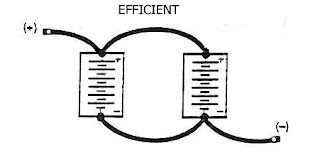Battery Basics – How to Care For RV Batteries
In this article, we’ll go over how you should care for your RV battery. This helps your battery last longer saving you money in future battery replacements. It can also help prevent finding out you have a dead battery when you go out camping. Such a pain to get away from it all only to have issues with running lights, fan, and your water pump.
Battery Basics – A Series to Learn About Batteries
Battery Basics – Types of RV Batteries
Battery Basics – How to Care for RV Batteries
Battery Basics – True Deep Cycle vs Dual Purpose
Battery Basics – How to Wire RV Batteries
Battery Basics – RV Battery Sizing


Sign up for the best off-grid solar info!
Some Simple Tips on RV Battery Care
For many part-time RV’ers fall is the time of year when they prepare their RVs for winter. RVs have various parts that require some prep for seasonal storage, like drinking all fluids and adding anti-freeze. There are some great checklists out there that can help guide you as to what to do.
Here is a comprehensive RV Winterizing Checklist by KOA Kampgrounds.
However, many of these checklists only address systems in the RV that may have standing water, many don’t even mention checking the battery. I advise all RV owners to give their batteries a good look when they’re winterizing them. It can help prevent and “surprise” issues on your first camp trip for next year.
Here is a simple checklist for inspecting and preparing your battery(s) for winter.
- Check for loose cables and wires. Tighten or replace any loose connection.
- Check the battery post, cables, and wires for corrosion.
- Check the battery for cleanliness, mainly on top of the battery.
- Check water levels in WET cell batteries.
- Ensure that the batteries are connected correctly.
- Connect a smart charger to maintain the battery during storage.
Check for Loose Cables and Wires
Loose connections create various issues for electrical components. Check to make sure your battery cables are very tight, not just hand tight. All your wire connections need to have secure connections – ring terminals, fuse holder splices, butt splices. Any connection that you can disconnect by tugging on it or twisting it by hand should be replaced and properly secure.
Check the Battery Post, Cables, and Wires for Corrosion
Corrosion reduces the available power the battery can provide. It also reduces the ability of the battery to be charged effectively from a charging source, solar power, or other sources. Ensure that the battery terminals are clean of any green corrosion, follow this by checking any cables or wires.
If the battery terminals are corroded you must clean the terminals and anything in contact with the terminals. This can be accomplished by sanding, scraping, and scrubbing the terminals or any other metal parts. A solution of baking soda and water helps break down the corrosion.
Any wires that show green corrosion should be either replaces or cut back until no sign of green corrosion remains. Generally, I recommend a full replacement, however, the wire can also be cut back enough – but be careful – one strand of wire can be corroded, hidden from plain sight many inches up into the wire.
Check the Battery for Cleanliness
A visibly dirty battery can have a voltage drain from the mixture of sediment and moisture connecting with the electrical potential of the battery. Make sure the tops and sides of a battery are clean and dry. Create a solution of baking soda and water to scrub the battery with, and dry well.
Check Water levels in WET Cell Battery
Use extreme caution when working with WET cell batteries as the fluid is very acidic. Use distilled water to top off the water levels as other types of water could cause contamination.
A WET cell battery is a type of battery that requires regular maintenance. When using a WET-type battery water levels should be checked monthly or bi-monthly. When storing WET-type batteries the water level should be checked before and after storage.
Check the water level of WET cell batteries only after the battery has a full charge and has time to sit (approx. 5 to 6 hours). Filling the battery fully then charging it can cause the fluids to overflow the battery compartment. Make sure to check for the manufacturer’s guidance on how to fill your battery.
It’s good practice to get a battery hydrometer (what is it and how to use it, click to read) and check the weight of the water-acid solution. Learn how to use it and how to spot a bad cell in a battery. This can prevent having a poor experience with a battery that’s on it’s last leg.
Ensure the Batteries are Connected Correctly
The largest single error that we find in RV battery installations is the improper connections of the RV to the batteries. When using multiple batteries the current has to flow through all batteries. The connections to the battery for charging and out to the RV to power electrical loads have to be on separate batteries. Essentially the positive of battery 1 and the negative of battery 2, 3, 4, 5, or 6.
Avoid Connecting to a Single Battery in a Multi-Battery System
Never connect the charging cables or the cables out to the RV’s electrical system to just one single battery in multiple battery configurations.
Electricity will flow from or to the path of least resistance. The first battery is the best source of power when connected this way. That battery sees the most usage and doesn’t balance well with the other batteries.


Contact us if you need more clarification. Improperly connecting the cables to the batteries will lead to poor performance and a shortened battery life.
Connect a Smart Charger to Maintain the Battery During Storage
Many RVs still come equipped with an inefficient converter/charger charging system. Batteries lose between 4 and 10% of their charge a month. Leaving a battery without any charging for long periods of time will shorten the life of the battery. Common RV batteries love to be fully charged, or at least 75% and more.
A smart charger is a 3 stage (or automatic) charger that will shut off and turn on automatically when the battery needs it.
However, in recent years RVs have been coming equipped with a better, but not great 2-stage charger. This type of charger turns off the charger at a certain voltage and then turns on again when it reaches a much lower voltage. This is better than a 1 stage charger but doesn’t fully extend the life of the battery(s).
Alternatively, you can get a solar system on your RV that will charge the batter as long as the sun is shining. Great for if you store your RV outside. They also make small off-grid solar systems just for battery maintenance that can be connected or disconnected when needed.
Here are some solar maintainers to check out.
Good for single or dual batteries. No charge controller is needed.
These have a special charging algorithm that can revive dead batteries or extend good batteries. But pricey.
Portables can be used for larger banks. Use this for big battery banks. Has a charge controller so it won’t overcharge.
It’s important to either fully disconnect the battery from the RV for storage or to compensate for any parasitic loads with a trickle charger. Most parasitic loads are very small, but small loads add up over time. However, if you have a solar system that gets daily sunlight you can leave it connected throughout the winter.
Need Help, We Can Help
We help people wade through the complexities of solar battery charging. RV batteries are a big topic. We have years of experience and knowledge when it comes to them. We hope this article helped. We’ll be creating more when we get a chance. If you want to be notified when we have more info, sign up below.
And for this reason, if you’re still confused you can reach out to us. We can do an energy audit for you and calculate what size battery, type, and voltage might work for you. We can also size your solar system. We’ll need to hop on a call and get some info and ask some questions so we can get you rolling with some good recommendations.
For this consultation, we do have a fee of $49.95 per consult. Just reach out to us – info@backcountrysolar.com if interested.



